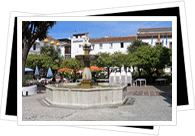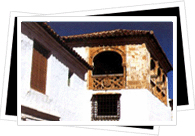Simple lines, classic columns and graceful inner courtyards – this is essentially what Renaissance architecture is all about. It is a return to ancient Greek and Roman architectural styles. This architectural style originated from Italy and is usually appended to existing Gothic structures.
In Marbella, Spain, the following are examples of Renaissance architecture:
- The Fountain to be found in the Plaza de los Naranjos.  This Renaissance fountain is a welcome addition to the already beautiful surroundings of the plaza. It is placed at the end of Nueva Street, at the point where it joins the Plaza. The first Mayor of Christian Marbella had it built back in 1504. Don Alonso de Bazan willed this home to help the needy people of Marbella. Today, it has a very important function as it houses one of Spain’s best art collections – the Museum of Spanish Contemporary Engravings.
This Renaissance fountain is a welcome addition to the already beautiful surroundings of the plaza. It is placed at the end of Nueva Street, at the point where it joins the Plaza. The first Mayor of Christian Marbella had it built back in 1504. Don Alonso de Bazan willed this home to help the needy people of Marbella. Today, it has a very important function as it houses one of Spain’s best art collections – the Museum of Spanish Contemporary Engravings.
- The Chief Magistrate’s House is built with a mixture of Renaissance and Gothic - Mudejar styles. This feature is to be found in the stone façade and was built in 1552 and is considered one of Marbella’s unusual and oldest buildings. Its exterior lends further beauty t the already beautiful Plaza de los Naranjos.
- The Hospital de Bazan. Also known as the Hospital de la Encarnacion, it is believed to have been built in the 16th century. It is located at the Hospital Bazan street and features a delightful mixture of renaissance, gothic and Mudejar styles. It now houses the Museum for Contemporary Spanish Engravings. This building is beautiful, almost as stunning as the art in it. It has big stone pillars and an elevated ceiling.
 - The San Juan de Dios Hospital or the Real de la Misericordia. Like the Hospital de Bazan, this combines renaissance, Mudejar and gothic elements. This is the headquarters of the Maria Santisima de la Paz brotherhoods and the Nuestro Padre Jesus a su entrada en Jerusalen. It was royally founded and was built with the goal of helping passers by that are in need. It has an elaborate stone entrance, a wooden door with the shield of the San Juan de Dios Order and the royal shield. It is now home of the Museum of Contemporary Spanish Engravings.
- The San Juan de Dios Hospital or the Real de la Misericordia. Like the Hospital de Bazan, this combines renaissance, Mudejar and gothic elements. This is the headquarters of the Maria Santisima de la Paz brotherhoods and the Nuestro Padre Jesus a su entrada en Jerusalen. It was royally founded and was built with the goal of helping passers by that are in need. It has an elaborate stone entrance, a wooden door with the shield of the San Juan de Dios Order and the royal shield. It is now home of the Museum of Contemporary Spanish Engravings.
- The Town Council (Ayuntamiento) – this is a 16th century Renaissance building that was ordered by the Catholic Kings. On the right side of the façade are some commemorative plaques that were made in honor of the differing occasions of the city – the conquering of the city by the Catholic Kings, the bringing of water in 1632, the expansion of the building in 1779.
- The Encarnacion Church. Built in 1618, this cathedral is an impressive structure. Its renaissance features are found in the layout of the naves and lunettes on the front. The structure itself is made of the Basilica type and since it is not a pilgrim’s church, it does not have an apse at the back of the altar.